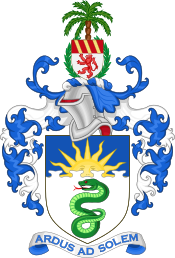
The University of Manchester Institute of Science and Technology (UMIST) was a university based in the centre of the city of Manchester in England. It specialised in technical and scientific subjects and was a major centre for research. On 1 October 2004, it amalgamated with the Victoria University of Manchester to produce a new entity called the University of Manchester.

The University of Manchester is a public research university in Manchester, England. The main campus is south of Manchester City Centre on Oxford Road. The university owns and operates major cultural assets such as the Manchester Museum, The Whitworth art gallery, the John Rylands Library, the Tabley House Collection and the Jodrell Bank Observatory – a UNESCO World Heritage Site. The University of Manchester is considered a red brick university, a product of the civic university movement of the late 19th century. The current University of Manchester was formed in 2004 following the merger of the University of Manchester Institute of Science and Technology (UMIST) and the Victoria University of Manchester. This followed a century of the two institutions working closely with one another.
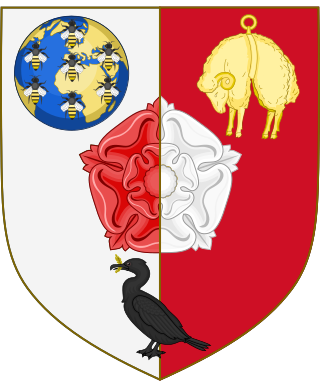
Victoria University was an English federal university established by royal charter on 20 April 1880 at Manchester. It was the fifth university founded in England, established as a university for the North of England open to affiliation by colleges such as Owens College, which immediately did so. University College Liverpool joined the university in 1884, followed by Yorkshire College, Leeds, in 1887. The university and the colleges were distinct corporate bodies until Owens College merged with the university in 1904. A supplemental charter of 1883 enabled the granting of degrees in medicine and surgery.
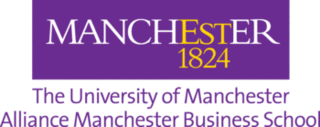
Alliance Manchester Business School is the business school of the University of Manchester in Manchester, England. It is one of the oldest business schools in the UK, and provides education to undergraduates, postgraduates and executives.

The Barnes Wallis Building/Wright Robinson Hall is a university building in central Manchester. It forms part of the campus of the former University of Manchester Institute of Science and Technology, which merged in 2004 with the nearby Victoria University of Manchester.

The Schuster Laboratory houses the Department of Physics and Astronomy, part of the Faculty of Science and Engineering, at the University of Manchester. It is named after Arthur Schuster and is located in Brunswick Park on the main campus of the university.
The Faculty of Science and Engineering (FSE) is one of the three faculties that comprise the University of Manchester in northern England. Established in October 2004, the faculty was originally called the Faculty of Engineering and Physical Sciences. It was renamed in 2016, following the abolition of the Faculty of Life Science and the incorporation of some aspects of life sciences into the departments of Chemistry and Earth and Environmental Sciences. It is organised into 2 schools and 9 departments: Chemical Engineering and Analytical Science; Chemistry; Computer Science; Earth and Environmental Sciences; Physics and Astronomy; Electrical & Electronic Engineering; Materials; Mathematics; and Mechanical, Aerospace and Civil Engineering.
The Department of Mechanical, Aerospace & Civil Engineering at the University of Manchester was formed from three departments in the 2004 merger between the Victoria University of Manchester (VUM) and the University of Manchester Institute of Science and Technology (UMIST). The merged departments were the Department of Civil and Construction Engineering which was joint between both universities, the Department of Mechanical Aerospace and Manufacturing Engineering at UMIST and the Manchester School of Engineering at VUM.
Frederick William Ratcliffe is an English philologist and librarian. He has a Ph.D. in German, given for his thesis on Heinrich von Mügeln at the University of Manchester. From 1954 he was an assistant librarian or sublibrarian in the universities of Manchester, Glasgow, and Newcastle upon Tyne. He succeeded Moses Tyson as the University Librarian at Manchester in 1965 and from 1972 was additionally director of the John Rylands University Library. In 1980 he became University Librarian at the University of Cambridge where he remained until his retirement in 1994. From 1995 to 2000 he was Parker Librarian at the Parker Library, Corpus Christi College. He has written a number of papers on the subject of librarianship including the preservation of library materials. He was born in Leek on 28 May 1927.
Moses Tyson, was a British historian and librarian who was Keeper of Western Manuscripts at the John Rylands Library from 1927 to 1935 and then Librarian of the Manchester University Library from 1935 until 1965. He was the first University Librarian to be a member of the University Senate.
The Bogle Stroll is a sponsored 55-mile walk conducted annually in Manchester, United Kingdom. Participants in the walk raise money for charity of their choice.

Greygarth Hall is a catered inter-university hall of residence for men, situated in Victoria Park, south Manchester, England. It is one of the halls on the "Rusholme campus" within 3 minutes walk of the famous Curry Mile. Greygarth Hall was founded in 1961, and in 2010-11 was extensively refurbished. The hall is a grade II listed building and was a University of Manchester Licensed Hall from 1965 until the university abolished the 'licensed' state in the early 2000s.
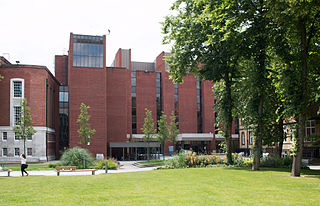
The University of Manchester Library is the library system and information service of the University of Manchester. The main library is on the Oxford Road campus of the university, with its entrance on Burlington Street. There are also ten other library sites, eight spread out across the university's campus, plus The John Rylands Library on Deansgate and the Ahmed Iqbal Ullah Race Relations Resource Centre situated inside Manchester Central Library.
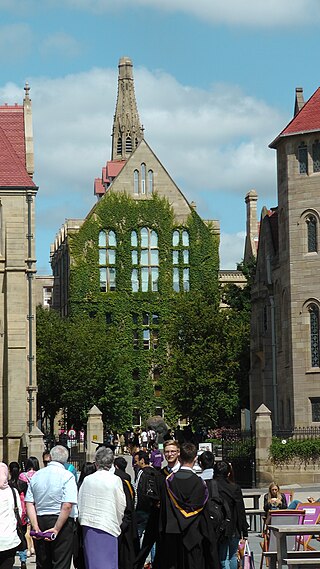
The Beyer building is part of the Old Quadrangle, of the University of Manchester, on Oxford Road, Manchester. The quadrangle comprises the oldest buildings of the University and was completed in 1904, prior to the Owens College becoming the Victoria University of Manchester. The original college building on Oxford Road was built in 1873. The Beyer building was the second side to be completed in 1887. It was funded entirely by Charles Beyer through his will of 1876. Beyer was a well known philanthropist and co-founder of Beyer, Peacock & Company, one of the world's most famous locomotive manufacturers. He was a life governor of Owens college, actively involved in the Owens College Extension Movement, and the single biggest donor to the Extension fund, which in total raised over £100,000 to construct the original building at Oxford Road.
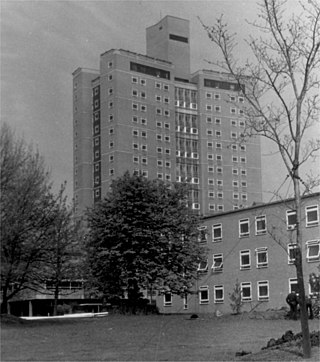
The Fallowfield Campus is the main residential campus of the University of Manchester. It is located in Fallowfield, Manchester, 2 miles (3 km) south of the main university site, to which it is connected by Wilmslow Road and the A34.

J. Lewis Womersley CBE, FRIBA, FRTPI, Hon. LL.D and MA was a British architect and town planner best known for his work as City Architect for Sheffield, leading the team that created the Gleadless Valley, Hyde Park and Park Hill estates. Womersley's passion was "incorporating buildings, roads, paths, play-grounds, schools and superb landscaping as the complete architectural environment."
Brian Sebastian Pullan, FBA was a British historian and academic. He was Full Professor of Modern History at the University of Manchester from 1973 to 1998.

The Department of Earth and Environmental Sciences at The University of Manchester is one of the oldest earth and environmental science departments in the UK. The Department takes roughly 100 new undergraduates and 140 postgraduates each year, and employs 90 members of academic staff, 41 postdoctoral researchers, 27 technical staff and 20 administrative staff.

The Kilburn Building is a building on the Oxford Road in Manchester which is home to the Department of Computer Science at the University of Manchester. The building was designed by the Building Design Partnership and completed in 1972, with three storeys in a square shape, measuring 76 by 76 metres. The building was formerly known as the Computer Building changing its name in 2001 in honour of Tom Kilburn who died in the same year.

Manchester University Boat Club (MUBC) is the rowing club of the University of Manchester. While university rowing at Manchester has earlier origins, the present-day club was founded in 1932, and has been based on the Bridgewater Canal since 1963. It is one of the largest sports clubs at the University of Manchester, taking in over 100 members every year.
